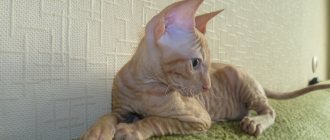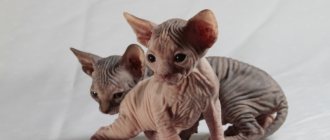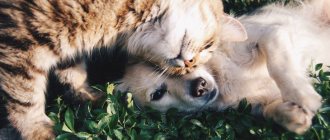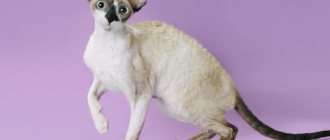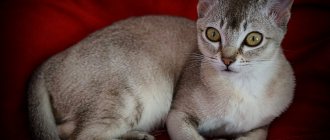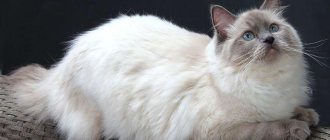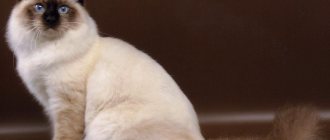Features and habits of the Sphynx Brush cat
Cats without hair are no longer considered a novelty, and it is no longer possible to surprise with them. Modern breeds of such cats make many people smile and want to touch their skin and stroke them. The Sphynx Brush is a cat with little fur on its body - the hair is short and sparse, more like fluff.
Don Sphynx brush.
Velor happiness: we tell everything about sphinxes
Smooth and pleasant skin, beautiful eyes, big ears and cute folds on the body. Who do you think we're talking about? No, not about people who have been in quarantine for several months. We're talking about cats! You've probably heard about such a stunning and unusual breed as the Sphynx. These four-legged animals have no fur coat at all, which makes them truly special. We offer to learn more about these hairless cats, study their diet, learn how to properly care for them, and much, much more.
What does the Don Sphynx look like?
After looking at the photo of the Don Sphynx, one gets the impression that he has a lot in common with Egyptian cats. The size of representatives of this breed reaches 25-30 cm in height at the withers. How much a Donchak should weigh depends on gender - boys are always larger. They reach 5-7 kg. The weight of girls is more modest and amounts to 3.5-5 kg.
Muzzle
The breed is characterized by a wedge-shaped head with pronounced cheekbones and a strong-willed chin. On the rounded muzzle there is a straight nose, connected to the wrinkled forehead by a pronounced stop. On the top of the head are large, widely set ears, rounded at the tips.
The Donchak has slightly slanted, almond-shaped eyes that lack eyelashes. Short vibrissae are twisted into a spiral. They often break off, and sometimes they don’t grow back at all. Defects of the breed include a narrow or rounded head, too small ears, inversion of the eyelids and an underbite of more than 2 mm.
Body type
The low and thin neck goes into a dense and muscular body, expanding in the croup and chest. The front limbs of the Doncha are shorter than the hind limbs. They end in strong and powerful paws with elongated toes. The flexible, whip-like tail tapers to a tip. An abundance of folds is characteristic of the neck, armpits, paws, abdomen, groin area and tail.
Skin and color
The elastic skin of the Don people is completely bald or covered with soft down. Depending on the type and structure of the existing fur, there are 4 varieties of the Don Sphynx:
- Brush
. The most unusual species with sparse curly fur. The length of its hairs is the maximum. Such animals are not allowed for exhibitions, but are used for breeding. With age, the number of curly hairs decreases. - Flock
. The body is covered with “peach fuzz”, which gradually disappears. - Velor
. Unlike flocks, the fluff of a velor cat is longer and thicker. It also disappears as they grow older, but sometimes the coarsest hairs remain on the head and paws. - Hollowborn
. The fur is completely absent. The skin is covered with many wrinkles and is slightly sticky to the touch due to a special secretion. It is secreted by the sebaceous glands to protect against infections.
Among the colors of the Don Sphynx, any colors are allowed except lilac and chocolate. Due to the lack of fur, these cats rarely cause allergies in people.
At what month does a Sphynx cat lose all its hair?
Currently, there are three intra-breed varieties: barebred (rubber), velor “flocked” (with rudimentary hairs all over the body) and “brush” (with thick wavy and very soft hair or with hard, crimped, almost broken hair). One litter can produce both bare-born and “brush” kittens and velor kittens. If at birth a bald spot (“tonsure”) appears on the crown of the kittens of the last two types, then over time these kittens will shed their hair and turn into true sphinxes. How quickly this will happen can be determined at the age of 1-2 months. If the coat remains fine and silky at this age, the kitten will “undress” at about 4-5 months. If the coat is harsh to the touch, shedding the coat can take up to 1.5-2 years. However, the process of “undressing” is individual for each animal.
Naked and velor varieties of Don Sphynxes compete for titles and are successfully exhibited at various exhibitions. Brushes may be exhibited without the right to receive titles. At the same time, they are very actively used in breeding, especially when paired with naked-born. Some “brushes”, after reaching puberty, begin to intensively shed their hair and become completely hairless, with the exception of the limbs, on which short, soft and slightly wavy hair remains. Such animals can also be exhibited at exhibitions, they receive titles.
Source
pros
Many owners note the friendly and easy-going nature of Sphynx cats with fur. Cats of this breed have the following advantages:
- lack of aggression;
- high intelligence;
- learning ability;
- good harmony with other species of animals;
- pickiness in food;
- cleanliness.
In addition, Sphynx cats with fur are considered healing cats. They have increased heat exchange, and the surface of the hair always remains hot. These animals can be used as living heating pads. They are extremely affectionate and love to cuddle up to the human body.
Straight-haired cats
Straight-haired Sphynx cats are covered with regular hair. They have straight mustaches. With age, the hair does not fall off; the fur remains forever.
Straight-haired cats are obtained by crossing Sphynxes with Siamese and Oriental breeds. They lack the hairless gene. Despite the presence of hair, straight-haired animals are classified as sphinxes. Their appearance, character and habits are characteristic of this breed of cats. The hair on the body is considered a heritage of Oriental cats.
Straight-haired animals are mainly found among Peterbalds, less often among Don Sphynxes. Sometimes kittens with fur are born to completely hairless individuals. This is due to failures in genetics.
This type of sphinx cannot take part in exhibitions. Straight-haired kittens are discarded from breeding. The presence of permanent hair is considered a deviation from breed standards.
Flock
Newborn kittens may appear hairless. But upon closer examination, you can notice sparse hairs no more than 2 mm long on the skin. The Sphynx flock has wool that resembles velvet in its structure. It covers the entire body of the animal.
The short coat persists only in childhood and young adulthood. As the animal grows, the hairs gradually become thinner and then disappear altogether. By about 2 years of age, cats become completely hairless.
How to understand: will the kitten be fluffy?
Before getting any pet, everyone thinks about what size the animal will be when it grows up, or what its coat will be like - smooth, long, short, voluminous, and whether its color will change. Those who are planning to get a cat pay special attention to the fur of their future pet. It is very difficult for an ignorant person to determine at first glance whether a kitten will be fluffy, which is why today we will tell you in detail how to determine whether a kitten will be fluffy when it grows up.
Velours
Velor cats have longer and fuller coats than flocked cats. The Velor Sphynx is born with velvet hair that is clearly visible to the touch. The length of the villi can reach up to 3 mm. Velor Peterbalds have longer hair on their paws, face and tail than on other parts of the body.
With age, hair follicles die off. Velor Don Sphynxes completely lose their hair. In adulthood, these cats appear completely hairless. Adult Peterbalds may still have remnants of hair on their paws and head.
Types of Sphynx coats
Brush animals were not bred on purpose - they appeared as a result of a gene mutation after crossing different types of cats. There are several types of Sphynx with fur, differing in the length and type of hair.
Flock
The body of pets is covered with a thin velvet pile, similar to the fluff on the surface of a peach. The fluff is very soft to the touch and almost invisible. The densest coat is found on the paws and tail. In the absence of developmental anomalies, by the age of 2 years all the hairs fall out on their own, and the animal’s skin is completely exposed.
Velours
The velor pet of the Sphynx breed has a bald head, and the hair length on the body reaches 2–5 mm - in appearance they resemble partially bald street cats. Most often, by adulthood, these animals also become bald, but sometimes the fur remains throughout their lives. Often the lint remains only on the paws and tail.
Brush
Pets of this breed differ in the density of their coat:
- Brush velor Sphynx kittens have hard hair that resembles stubble. On the sides and neck the fur is thinner, the skin is visible through it. With age, the fur can soften, and then the velor brushed Sphynx becomes more similar to representatives of the flock breed.
- After birth, the body of the Pointed Brush is covered with long and thick hair, and a barely visible bald patch stands out on the head. By 18–24 months, the length of the hair on the body remains about 1–2 mm, and on the tail, muzzle and paws the hair reaches 10 mm, becoming curly in some places.
- A kitten of the dense brush breed looks like an animal with straight fur - it does not have a bald spot on its head. Over time, the structure of the hairline changes - it becomes thick, and the skin is practically not visible through it. On the paws, chest and tail, the hair is longer and stiffer, and can be either straight or curly.
Note! Pets of this breed do not take part in exhibitions, but they are crossed with other types of sphinxes - this allows them to get strong offspring. This selection is due to the fact that when two representatives of hairless sphinxes are brought together, very weak or dead kittens are born.
Straight-haired
Straight-haired Sphynxes do not go bald over the years - they still have short hair that fits tightly to the skin, and pronounced, long whiskers. The breed appeared as a result of the mixing of Siamese or Oriental cats with Sphynx cats.
Canadian Sphynx
This cat breed is never completely naked. Sphynx kittens are not born hairless. Their hairline resembles suede. In adulthood, hair remains on the nose, behind the ears, as well as on the paws and tail. It looks like thin twisted fibers. The Canadian Sphynxes have all of the above varieties of coat.
How to choose a kitten
It is recommended to purchase a kitten only from trusted nurseries, since they may offer you not an exotic baby, but a sick animal. This is due to the difficulties of breeding the breed and the dishonesty of sellers.
You should not buy a kitten that is too young, as its body is still weak and can get an infection when moving, even under stress.
Reference! The optimal age for a baby to buy starts from 3 months. By this time, the baby is already strong and has the necessary vaccinations.
If your future pet is a personal companion and not a show winner, then it is enough to make sure that he is healthy. The kitten should be active, cheerful, and not show aggression or fear at the sight of a person. Sometimes kittens have a small rash on their tail - there is nothing wrong with that, it will go away on its own over time.
The final color of the kitten, as well as the color of the eyes, become clear to an experienced breeder already in the first weeks of the baby’s life.
It’s worth noting right away that sphinxes are not a cheap pleasure. If you are offered to buy a kitten for 3-4 thousand rubles, in this case there can be no talk of any pedigree.
The price of kittens in trusted nurseries starts from 10 thousand rubles.
Kittens that have deviations from breed standards are a little cheaper. They are not critical if you take a handsome bald man for your soul.
But promising kids - potential exhibitors and future producers, whose parents have championship titles, will cost at least 15 thousand rubles .
Differences between the Canadian and Don Sphynx
Cats without fur, with a lot of folds, look like aliens. They are all called Sphynxes, and not everyone knows that this breed has its own species that differ from each other. Canadian and Don Sphynxes have the following differences:
- species have different baldness genes (dominant and recessive);
- Canadian Sphynxes are always covered with barely noticeable fluff, and Don Sphynxes can be completely hairless (“rubber”);
- Canadian individuals are endowed with large round eyes, while Don individuals have an almond-shaped eye shape;
- Canadians have no mustache at all;
- in the Don species, the tail is of medium length and thickness, straight and rather strong, in contrast to the Canadians, whose tail is weak, thin and pointed at the end;
- Don individuals have a strong torso and a strong muscular system, in contrast to the underdeveloped muscles of Canadians.
Skin and coat types of sphinxes
Only 4 types of sphinxes fit the description of hairless cats. The first of these to appear were representatives of the Canadian breed, whose targeted selection began in 1960. Although the name of these sphinxes cemented their affiliation with the Country of the Maple Leaf, the main experiments were carried out in the United States.
Read also: How to make any printer network
The mutation that led to the hair loss occurred naturally for unknown reasons. The Canadian Sphynx is born with fur, and then carries residual signs of it throughout its life. He only looks completely naked from afar. In fact, the thick skin is covered with fluff (up to 2 mm), and there is short hair on the bridge of the nose. Hair growth is also allowed on the inside of the ears, between the toes, on the belly and tail. To the touch, the skin of the Canadian Sphynx gives the impression of velor or velvet pile - an almost imperceptible gentle coating.
“Canadians” are born in this form and no significant transformations occur to them throughout their lives.
Another branch is the Don Sphynx, which was bred in Russia 20 years later. The hairlessness of this breed is due to a mutation of completely different genes and, although externally similar to the Canadian Sphynx, the domestic species has significant differences:
Rules of care
These cats do not need serious care:
- Sphynx Brush cats are fed natural or premium dry food. Also, the cat’s body constantly needs a large amount of fluid and properly selected vitamins.
- Don't forget that the Sphynx Brush's ears and teeth need regular cleaning. Optimally - once a week.
- Brush cats need to be bathed regularly. You can buy a special product or take a good baby shampoo.
- Cats don't have eyelashes, so pay attention to their eyes. This is especially true for kittens - it is better to wipe their eyes with a damp, clean swab once a day.
Important! The hair of a plush Sphynx can change due to a new diet, temperature, humidity in the room, changes in hormonal levels during gestation or estrus.
How to care for brush cats
No special care is required for the brushes. In this regard, they are not much different from other sphinxes.
These cats need:
- Daily wiping of the eyes with damp swabs or wipes soaked in a special eye care product, herbal decoction (chamomile, calendula) or tea leaves.
- Clean your ears at least once every 5-7 days to remove dust, dirt and sulfur secretions. Use cotton pads and swabs with a specialized solution for caring for the ears of animals or pharmaceutical preparations (hydrogen peroxide, chlorhexidine).
- Skin care, consisting of : periodically wiping the skin with a damp sponge or cloth to remove the brownish secretion produced; combing existing fur (about once a week) with a stiff hair brush or a simple short-toothed comb; bathing when soiled (preferably no more than once a month) with a special gentle shampoo for sphinxes or baby soap; additional moisturizing of the skin with nourishing cream or cosmetic oil.
- Trimming nails (2-3 times a month) using a nail clipper (special scissors).
Thanks to the presence of wool, brushes freeze less, but in cold weather they still need warm clothes.
Skin care and bathing
The Sphynx breed, due to its physiological characteristics, needs more frequent bathing than their furry counterparts. This procedure must be done correctly so that the cat does not experience stress and avoid health problems. It is better to do this in a shallow container or bath; the depth of the water should not exceed 15 cm. Cats are often frightened by the stream of flowing water.
It is recommended to use special care formulations or products for children as shampoo. They do not contain harsh ingredients that can cause irritation, and this breed has very sensitive skin.
Sphynx dogs have a high temperature, so they need to be washed with preheated water. The optimal temperature should be 36-39 degrees. When washing an animal, you need to calmly talk to it and stroke it so that the animal remains calm and does not get nervous. The amount of shampoo depends on the degree of soiling of the cat.
Table describing care procedures for Sphynx cats.
In some cases, you can do without it altogether by simply bathing it in warm water. When bathing, water should not get into the animal's ears, as this can lead to inflammatory processes. In this case, it is not recommended to wash your hair at all; you can use wet wipes.
It is not recommended to wash kittens that have recently been given a new home and have not yet had time to adapt to their new living conditions. The Sphynx should be bathed at least once every ten days. After bathing, the animal should be thoroughly dried and the room should be warm. Otherwise, the cat may catch a cold.
Sphynx kitten at six months.
Content Features
Many people get hairless cats in order to avoid endless combing and cleaning up fluff throughout the apartment. But, alas, sphinxes are far from the easiest breed to keep. If you want your pet to be in excellent shape and in a good mood, you will have to constantly spend a lot of money and time for this. And here’s a paradox: the less fur a cat has, the more expensive its beauty requires. In this sense, velor is the optimal coating option.
To wash or not to wash?
These amazing cats are special in everything - and in their care too. They are neat and very clean, but their own washing is still not enough; the owner must help the pet care for sensitive skin so that irritation and dermatological diseases that hairless animals are prone to do not occur. Mandatory hygiene for sphinxes has much in common, but there are also differences - depending on the type of coat.
All sphinxes are amazingly clean
All cats of this breed group “sweat”: their sebaceous glands secrete a special lubricant that cannot be distributed throughout the fur and remains on the skin. Without such natural nourishment, the skin will dry out and begin to peel. As soon as, while stroking your pet, you notice that your palm is dirty, it’s time to arrange a bath day.
Starting from the age of two months, “rubber” Sphynx cats are bathed weekly, using only special shampoos for hairless cats. Such frequent washing usually does not irritate the delicate skin and does not provoke allergies.
But you can also use other cleaning products, for example, special cat wipes. Velor cats can be bathed less often - once or twice a month as they become dirty - and you can also wipe off dust and dirt adhering to the skin with napkins - especially a lot of it collects in the groin and armpits. Too frequent bathing is not beneficial for any cat, including a hairless one. Remember also that cosmetics (creams, gels, lotions and conditioners) are suitable for sphinxes only with a certain acidity - with a pH of 3.8 to 4.5.
Hairless cats love to splash in warm water
The tail requires special care, the sebaceous glands on which are often clogged, inflamed, and covered with black dots - acne. To prevent this from happening, the tail should be washed with special products more often than the entire cat. The large eyes and huge ears of sphinxes also come into the area of increased attention - they must be kept clean so that there is no risk of infection. Like all cats, you need to monitor the condition of the teeth and claws of “baldy cats”.
Warm and satisfying
Warmth is the main condition for the happiness and health of any Sphynx. In the house where he lives, cold and drafts must be strictly prohibited. Warm beds, cozy clothes made of soft fabrics without seams - all this is included in the mandatory arsenal of the sphinx owner. If you do not provide the animal with a comfortable temperature, it will try to warm up near heating devices, where it can get skin burns. Also, exposure to direct sunlight often results in burns.
These cats always want to stay warm
Hairless cats that are always freezing are characterized by an accelerated metabolism and, as a result, an increased appetite. It is very important to correctly maintain a balance between the quantity and quality of food in the daily diet of such animals. Only practitioners with extensive experience can create a menu of natural products, so breeders usually recommend that those who get Sphynx dogs for the first time select ready-made food based on the tastes, health, and individual characteristics of their pet.
The following are considered the best ready-made food for sphinxes:
- Orijen Cat & Kitten (Canada) – holistic food;
- ACANA Grasslands for Cats (Canada) – holistic food;
- Purina Pro Plan Delicate (France) – super-premium;
- Royal Canin Sphynx Adult (USA, France) – premium class;
- Hill's Science Plan Adult Lamb (USA) – premium food.
The excellent condition of the skin and coat of your velor beauty is an unmistakable signal that the feeding regimen and menu have been chosen correctly. Pay special attention to the diet of sterilized animals.
A properly selected diet is very important for the Sphynx
As for breeding hairless cats, it is better to leave this complex topic to the professionals. Breeding work with all breeds of sphinxes is not only practice, but also a real science in which, alas, there are fewer discoveries than disappointments.
Finding a parent pair of sphinxes is not an easy task.
Character and special habits of brushes
These cats can be characterized as playful and inquisitive. Over time, they become full-fledged members of the family. They choose one master or favorite for themselves, they always obey him unquestioningly, carrying out all his commands. They treat other people with warmth and good nature. Also, the Sphynx Brush is intelligent, but tends to be touchy. However, he is not vindictive. You should not punish this animal physically and psychologically.
Brushes can be called empaths, capable of sensing changes in a person’s mood. They react to this, trying to pity and cheer up the person. Cats love affection, all kinds of manifestations of tenderness, care, and attention to themselves. This breed is characterized by quickly getting used to a new place, observing all the requirements that the owners place on them. If the animal refuses to visit the tray assigned to it, you just need to move it to another place.
Sphynx kittens.
Reviews
All owners of such tailed animals are very happy with them, it is impossible not to fall in love with them; as a rule, such pets become loved by all family members, even if someone is initially put off by their appearance. Cats of this variety are disciplined, easy to train and raise, and love to be photographed.
They are loyal and love their owners, meeting them at the doorstep and following them around the house everywhere. They often sleep in bed with people, love to purr on their knees and sleep in the warmth of human hugs.
To read: The smartest and most faithful dog German Shepherd: varieties, how to choose the right puppy?
Some take in adult animals, and they still quickly adapt to the new environment. They love children and easily find a common language with other representatives of the animal world. They do not spoil wallpaper and furniture, especially if you accustom them to scratching posts from childhood. They always go to the toilet in the litter box. The only thing that can be a problem for busy people is daily wiping, but for those who are already used to it, caring for a cat is a pleasure.
Petersburg brush (Peterbald)
Russian breed, in the selection of which Don cats took part. Just like their predecessors, these sphinxes are covered with curly hair and some of them remain in this form for the rest of their lives. The second half “undresses” not completely. In adult cats, dense growth is observed on the face, tail and may be on the paws. This option is called brush point due to the characteristic location of the hair at the ends of the body.
Why does the Sphynx begin to grow hair?
Kittens and adult Sphynx cats sometimes begin to grow hair. There may be several reasons.
- Cold weather.
With the onset of cold weather, most sphinxes are covered with short fluff; in some areas of the body the hair can be quite long. It can grow back even if it only got cold outside the window, but the temperature in the house was always maintained at a comfortable level. - Heredity.
Canadian Sphynxes are the most stable breed. The appearance of fur on them usually indicates the “sins” of the breeder and accidental interbreed matings. You can expect everything from Donetsk, Peterbald, Levkoy and other hairless breeds. They are on the path of becoming. It happens that kittens do not shed their fur and this cannot be predicted, and adult cats can grow and remain fluffy. - Hormonal changes.
Wool can grow rapidly or, on the contrary, fall out as a result of puberty, pregnancy, castration/sterilization, disruption of the endocrine system and other factors affecting the general hormonal balance.
Observations show that reasons such as feeding, illness, stress in combination with the above can affect the amount of hair in a hairless cat.
Regardless of the amount and length of the sphinx's fur, the character and habits usually do not change. Even in their fluffy form, they remain very gentle and sociable creatures who adore warmth and comfort.
Sources
- https://MyFavoritePet.ru/poroda-okras/pochemu-sfinks-pokryvaetsya-sherstyu.html
- https://medeponim.ru/pitomczy/samye-laskovye-i-umnye-domashnie-pitomczy-sfinks-s-sherstyu-volosatyj-opisanie-i-harakter-porody
- https://vplate.ru/sfinks/s-sherstyu/
- https://MoiKoty.ru/porody/sfinksy/brash
- https://ProKota24.ru/porody-koshek/sfinksy/sfinks-brash
- https://usatiki.ru/koshka-sfinks-s-sherstyu/
[collapse]
We recommend reading:
- An enclosure for a dog: how to make a beautiful warm outdoor enclosure with a winter road with your own hands - drawings, sizes, photos, projects, tips on how to build it yourself
- Features, varieties and photos of hypoallergenic cat breeds, how to care for them
- Caring for a dog's fur: how and what to comb properly, combs for long, short-haired, smooth-haired dogs, how to comb tangles, products - shampoo, spray
- Gampr (Armenian Wolfhound): all about the dog, photo, description of the breed, character, price
Hairless Sphynx cat: character
The unique character of the Sphynx, as well as their appearance, is the result of careful selection. These animals are not prone to displaying aggression or discontent. Kind, soft, sensitive, gentle, devoted Sphynxes are ideal pets.
They get along well with both older people and families with small children. A balanced character combined with a playful disposition helps these animals share the interests of each family member.
Sphynx cats get along well in families with small children.
IMPORTANT: Sphinxes are not vindictive, they quickly forget random insults, but they have a hard time experiencing loneliness.
Sphynxes love to interact with people and pets. They are not afraid of large dogs and lack the hunter's instinct, so a hairless cat's best friend can be a huge bulldog, a hamster or a parrot.
Sphynxes are playful and curious animals
Character
These cats are very curious and playful, they love to communicate, love to be looked at and played with. They quickly adapt to a new home and can easily cope with moving. They trust people, become very attached to their owner, and are loyal to him, like dogs. They accompany “their” person everywhere and do not leave him a single step. It is important for them to sleep on their owner’s lap or next to them in order to feel protected and loved.
Kids of this breed are extremely energetic, they are friendly and joyful, they often play pranks, chase each other, swing on curtains and adore their pets like their parents.
Cats often get cold both at home and outside, so they often sleep under a blanket. In winter they sit near the radiators, and in summer they bask in the sun. It happens that they even get a sunburn, their skin begins to peel off and come off in flakes.
Adult creatures are calm, love to sit on the windowsill and look at birds and passers-by. They get along well with children and other animals. It is better not to leave them alone for a long time; this can make the creature’s character aggressive, because it yearns for loneliness. Therefore, it is better to choose a different type if you are at work for a long time and there is no one at home. Another option is to get two cats, then they won’t get bored. They quickly get used to the tray, are clean and tidy.
Sphinxes are easy to offend, so you should treat them delicately, it’s better not to even raise your voice, because after screaming, your pet can sit in the corner for hours and remember the offense. He listens to his owner, follows his commands and tries to please him with his behavior.
He is calm and devoid of aggression, loves children and does not misbehave. He loves to play with children, allows himself to be dressed, wrapped in blankets, and painted. Will never scratch or bite. The Sphinx eats funny, he takes the tasty treat with his paw and puts it in his mouth, and opens his mouth to its full width over the bowl.
Health and disease of the Brush Sphynx
Once every three months, the cat needs to be prevented from worms, and revaccinated once a year, according to the recommendations of veterinarians. One of the most common problems these animals face is diseases associated with the skin - dermatitis, irritation, rashes, etc. Congenital pathologies are rare in this breed, but they can acquire diseases that are more characteristic of them.
- Microphthalmos. A congenital pathology of the eyelids, in which the eyeball is smaller or underdeveloped, which can cause poor vision or complete blindness. The reasons for this have not been fully identified and are only being studied. With this pathology, veterinarians simply remove the damaged eye and, if possible, perform plastic surgery.
- Short lower jaw. Most often, this pathology occurs among Donetsk residents. In this case, an incorrect bite occurs, the jaws come into contact with each other and do not completely align.
- Turning of the eyelids. Characterized by weakening of the muscles of the eyelid ligaments. Solved surgically.
- Dermatitis. Type of skin disease.
- Nipple hyperplasia. It is often transmitted genetically through the female line. The risk group includes females with light blue tones.
- Trichophytosis. The type of fungal disease is similar to lichen.
The breed is distinguished by its strong health. If you follow proper care, a balanced diet, contact veterinarians on time and get all the necessary vaccinations, your pet will be a joy for a long time. They rarely get sick, thereby causing their owners trouble and expense.
Tendency to diseases
Don Sphynx cats are predisposed to the following genetic diseases:
- congenital entropion of the eyelids (treated surgically);
- microphthalmos - reduction in the size of the eyeball (vision deteriorates);
- syndrome of “falling asleep kittens” (due to underdevelopment of the thymus gland, babies die);
- curvature of the caudal spine, causing a number of other pathologies (problems of the skeletal system, underdevelopment of the intestines, etc.);
- nipple hyperplasia in cats (if drugs to suppress sexual desire were used);
- undershot - shortening of the lower jaw (affects quality of life);
- skin vasculitis (inflammation of the vascular walls of the skin).
Most often, Don people have skin problems caused by excessive production of sebaceous glandular secretions. These may be the following diseases:
- dermatitis;
- eczema;
- trichophytosis;
- acne.
Absolutely naked individuals are susceptible to skin diseases more often than those with fur.
Don Sphynx and Peterbald
The Don Sphynx is a relatively young breed of cat with strong bones, well-developed muscles, and silky skin that is pleasant to human hands. The structural features that distinguish the appearance of hairless cats include:
- Graceful, straight back.
- Thin paws with a rounded shape and elongated toes.
- Smooth tail of medium length.
- Wedge-shaped skull with a flat forehead and clearly defined cheekbones.
- Pronounced cheek vibrissae.
- The ears are round and set high.
- The eyes can be of any color, the cut should be almond-shaped or oval.
- The presence of inconspicuous fluff on the body or its complete absence.
Subsequent attempts at selection gave rise to new types of sphinxes - Peterbald and Donskoy sphinx brush. The presence of a mutation in the genotype of the dominant Hbl allele provides for an early degree of baldness.
With the onset of cat maturity, hair loss increases and by the age of two, domestic cats acquire a fully formed appearance. According to the main criteria, these representatives of this breed are similar, but there are slight differences in appearance.
Naked, bald
Born with a complete absence of fur and tactile antennae-hairs, Sphynx cat kittens are born with open eyes, and the further color of the offspring can be easily determined by the pads of their paws.
Origin story
First of all, the difference between these two breeds lies in their origin.
Their homeland, as their name suggests, is Canada, or more precisely, the city of Ontario. It was in this second largest city in the country that the purposeful breeding of unusual hairless cats first began in the sixties of the last century.
It all started with a hairless kitten, born to an ordinary domestic cat, which, due to the lack of fur, was significantly different from its brothers and sisters. The amazing baby was named Prune. He turned out to be a carrier of the gene responsible for hairlessness.
But Prun was not destined to become the founder of a new unique breed of cats, since the breeders made one serious mistake. They crossed Prun exclusively with his sisters and nieces, and after several generations, the kittens, due to such close family ties, were born weak and often died a few days after birth.
Perhaps the world would never have known about the Canadian Sphynx if not for another hairless cat who was born in the American city of Wadena, and who was named Epidermis. American breeders turned out to be more cautious than Canadians, so they tried to find a cat to mate with Epidermis, with whom he would not be connected by blood ties.
There is a version that the Americans still managed to find distant descendants of Prun, who, together with Epidermis, were used for selection work to develop a new breed. This time, the breeders were lucky and were able to get several generations of completely healthy hairless kittens. The new breed was called the Canadian Sphynx, in honor of the first hairless cat born in Canada.
Don hairless cats are more than thirty years “younger” than their Canadian counterparts and appeared a thousand kilometers from America - in the Russian city of Rostov. Their story began with the bald cat Varvara, who was sheltered by a woman with a kind heart, Elena Kovaleva. Convinced that the pet’s hairlessness was due to some unknown disease, Elena even turned to veterinarians to cure her. But Varvara surprised her mistress by giving birth to babies as hairless as herself.
Russian breeders became interested in the unusual hairless kittens and wasted no time in starting selection work to breed them. The Russian sphinxes received their name in honor of the mighty deep river - the Don.
The difference between these two breeds is not only in their origin, but also in the fact that Canadian Hairless cats are today recognized by all international cat organizations, while the Don have received the status of only an experimental breed.
Description of the breed
The appearance of these animals is unusual - they have hard hair on their muzzle and paws, and the same on their tail. Sometimes there are specimens in which fur grows exclusively on the legs and the body is bald. Here are the distinctive features of all these animals:
- The fur is coarse, slightly curly. As a rule, babies are born with normal fur, and only then does it thin out. In the fall, many people grow longer hair - they are insulated for winter - and in the spring everything falls out, only the paws and tail remain hairy.
- They have no eyebrows, their skin is velvety, like velor, their mustache may be either absent or curly.
- The eyes are angled and oval.
- The back is strong, muscular, straight, the tail is also straight, the limbs are of medium length, thin, graceful, strong, the fingers also seem elongated.
- The tail is thin and elongated, rounded at the end.
- The head is wedge-shaped, the cheekbones and brow ridges are clearly visible.
- The muzzle is medium, the nose is without depressions or humps, the chin is small, the ears are large.
- The colors vary. The most common species are white, blue, red, black and sometimes lilac.
- The size is usually small, but there are also large cats.
- The skin is soft and wrinkled, elastic, and there are wrinkles on the head, tail, paws, neck and belly.
- There is no musky smell, males rarely mark territory.
- Females are smaller, they have a narrower chest, thin neck and small head. The weight of the animal is three to five kilograms.
- The lifespan of the animal is twelve to fifteen years.
- Babies' eyes open a few hours after birth.
There are three subtypes of hairy sphinxes:
- velor, whose hairs are sparse, short and dense,
- point, distinguished by velor hairs on the body and curly, short, coarse hair on the paws, tail and muzzle,
- dense, with hard and frequent fur, through which the body cannot be seen.
Interesting Facts
- Peterbald has other names: someone may know him as “Petrik” or “Bald Petya” due to his similarity with the monument to Peter the Great, where his body is just as voluminous, and his arms and legs are elongated.
- The St. Petersburg Sphynx is too demanding and talkative.
- They jump quite high and love to climb to the highest heights.
- Due to heat exchange, the temperature of the St. Petersburg Sphynx is high; owners often take advantage of this by placing the cat like a heating pad under a blanket during the cold season.
Preventive measures
To minimize the risk of a hoarse cough in cats, you need to adhere to the following rules:
- promptly vaccinate the animal against infectious diseases;
- carry out regular treatments against helminths and skin parasites;
- brush the hair of representatives of long-haired breeds daily;
- periodically feed gels and pastes to remove hair from the stomach;
- prevent pets from hypothermia;
- strictly observe the rules of cat hygiene and ensure high-quality living conditions;
- Do not feed your cat raw river fish and tubular bones.
Possible breed defects
Mating completely hairless cats with male cats is dangerous due to the appearance of offspring with serious genetic diseases. One of the parents must have wool (velor or brush). In this case, you may still end up with completely hairless kittens, or with fur that will subsequently disappear or become sparse.
A large number of folds in Peterbalds is not typical for the breed standards
The main defects include crooked front legs or too short, as in Canadian breeds, as well as a large number of folds.
If an individual has squint, kinks in the tail, and an aggressive character, which is not typical for this breed, such a candidate is not allowed to compete.
What is the difference between wool and hair?
All mammals have hair, be it human, pig, elephant, whale, cat or dog. But they have different appearances, depending on their functional purpose. Technically speaking, the term "fur" applies to mammals with very thick hair. The term "coat" is used for cats, except for hairless breeds, which have a minimal amount of fur, so the term "hair" is applied to them.
But like everything else, cat hair grows from follicles under the epidermis, although they come in different types and structures. By the way, a mustache is also considered hair. Cats have different types of hair growing from the same follicle. Each awn is surrounded by 6-12 fluffy hairs.
Hair has different textures and lengths on different parts of the body. Their density varies from breed to breed, the number of hair follicles in certain areas of the body. But on average, the density of the coat is about 200 hairs per square millimeter.
Directly under the skin are hair muscles that are sensitive to changes in ambient temperature. When a cat is scared, anxious or cold, the muscles tense, raising the hair. Protruding and fluffy, they give the animal a “frightening” appearance.

